Rafael Vargas-Suarez, known as Vargas-Suarez Universal, has the rare ability to make me catch my breath.
The impact of his artwork, in particular his large-scale wall drawings, and the revolutionary depth and breadth of his subject matter contrast with his quiet, subdued, and deliberate personal manner. He is both low- and high-tech, using elements on hand, not necessarily requiring special equipment, and at once sourcing and employing materials and data culled from science in general, space science in particular.
Vargas-Suarez Universal was born in Mexico City (1972) and raised in the Houston suburb of Clear Lake City, nearby to NASA’s Johnson Space Center. His early introduction to the realm of outer space and space exploration prompted him to study astronomy along with art history at the University of Texas at Austin. He moved to New York City in 1997 and has since lived and worked in Brooklyn.
Recognized for intricate wall drawings, Vargas-Suarez Universal creates paintings, drawings, and sound recordings of equal presence and significance, mainly inspired by spaceflight programs, astronomy, and aerospace architecture. At his studio one might encounter sound and video channeled through his laptop of a live feed from the International Space Station. Through NASA’s website, the artist is also able to acquire PDF files containing pages of data (words, photos, graphics) pertaining to space walks or systems checklists, among other bits and bytes of information. This data becomes the subject matter of his work, poetically transformed through his artistic language.
From my first encounter with the work of Vargas-Suarez Universal, I have been stopped in my tracks consistently.
In 2003, at the “Art Unknown” solo booth section of ARCO Madrid, his three 12- x 16-foot paper panels titled Virus Americanus created a sensational environment in red and white. At that time, I inquired about the artist, met him there, and have followed him since. That piece went on to be exhibited at the University of Salamanca in the 2005 exhibition “Barrocos & Neobarrocos” (“Baroque& Neo-Baroque”), and was later acquired by the Collection of DA2 (DomusArtium), also in Salamanca, Spain.
.
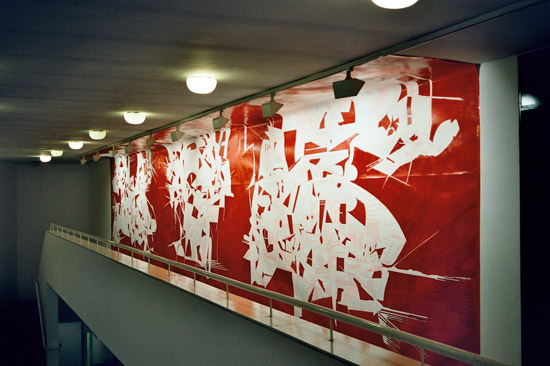
"Virus Americanus" by Vargas-Suarez Universal, 2003. Oil enamel on backdrop paper, 12 x 16 feet each. Collection 0f DA2 (Domus Artium), Salamanca, Spain. At "Barrocos & Neobarrocos" group exhibition, Palacio de Abrantes, University of Salamanca, Spain (2005).
.
Around the same time that I first met the artist, he created Space Station: Jersey (2003) at the Jersey City Museum, which I learned of but never had the opportunity to visit. (The museum closed due to financial difficulties in 2010 and reopened with limited hours in 2012). Documentary photographs transmit the intensity of this dense black and white, 16- x 28-foot drawing that wraps around a stairway in the museum.
.
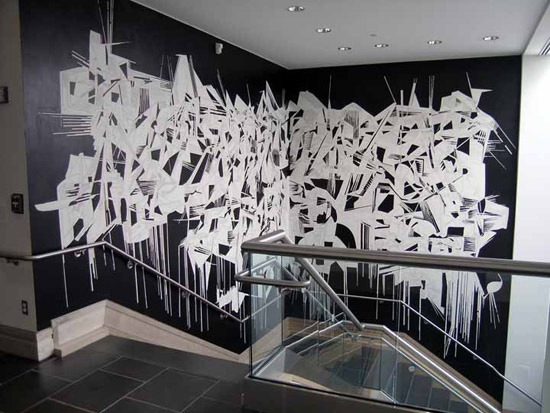
"Space Station: Jersey" by Vargas-Suarez Universal, 2003. Acrylic and enamel wall drawings, 16 x 28 feet. Jersey City Museum, Jersey City, NJ.
.
I also missed the chance to experience a creative intervention at Wave Hill in 2005, The Greenhouse Effect, for an exhibition titled “Out of Bounds.” As he is known to do, mainly out of practicality, Vargas-Suarez Universal utilized paints found on site and created a room environment in shades of green on white walls replete with classical moldings and a fireplace.
.
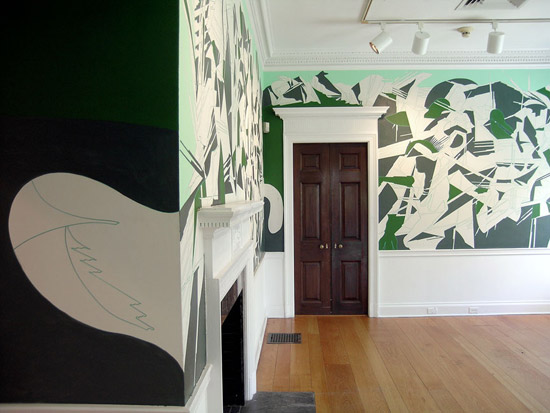
"Greenhouse Effect" by Vargas-Suarez Universal, 2005. Recycled acrylic paint, wall drawings, 7 1/4 feet x 63 1/2 feet. "Out of Bounds" group exhibition at Glyndor Gallery, Wave Hill, Bronx, NY.
.
While I was able to follow Vargas-Suarez Universal through the extensive documentation he maintains of his work, this was no replacement for experiencing it in person. In 2010 I created my own opportunity to witness the evolution of an installation piece when I asked him to exhibit in the gallery space I ran. I expected a conventional show of two-dimensional work. Instead, he proposed an installation of both wall drawing and individual paintings. Эльдорадо (El Dorado) was the first installation to combine these facets of his work.
I witnessed firsthand how he acquainted himself with the space and negotiated with its limitations (architectural details, windows, irregularities). His process was not planned or preconceived. Rather the paintings were grouped and placed, then he set about laying out his “vectors,” or compositional lines, in a fluid, methodical way. These vector lines seemed to radiate from the paintings, which themselves shone brilliantly, as their support was thermal blanket mounted on canvas, painted on with oil enamel.
.

"Эльдорадо (El Dorado)" by Vargas-Suarez Universal, 2010. Installation of paintings and wall drawings. Solar, East Hampton, New York.
.
There was no prior plan or rendering, nothing was sketched out beforehand. The composition was painted directly on the wall utilizing a straight edge made from discarded cardboard and the paint that was on hand in the gallery. Eighteen canvases, primarily 34- or 42-inch diamond shapes, were grouped and hung unconventionally, with the corners or edges touching in most instances. They transformed the gallery by themselves, but in combination with the vector wall drawings, the exhibition space was radically altered, along with one’s perception of and place in it.
When I learned of the installation in the Miller Theatre Lobby at Columbia University, I jumped at this fresh opportunity to visit one of Vargas-Suarez’s transformational wall drawings. Created over four days, Vector Composition No. 1 is, in a sense, another initiation for this artist, who is always willing to take chances, explore different themes, materials, and mediums.
.
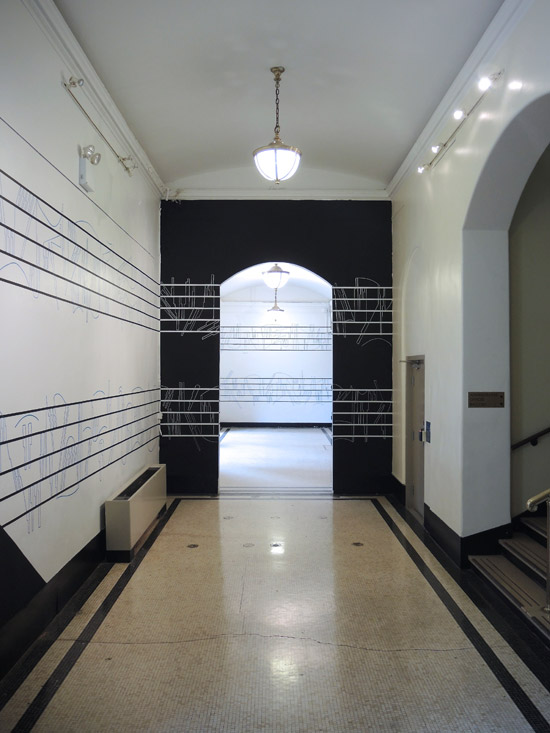
"Vector Composition No. 1" by Vargas-Suarez Universal, 2013. Acrylic, enamel and tape in-situ wall drawings. The Miller Theater at Columbia University, New York.
.
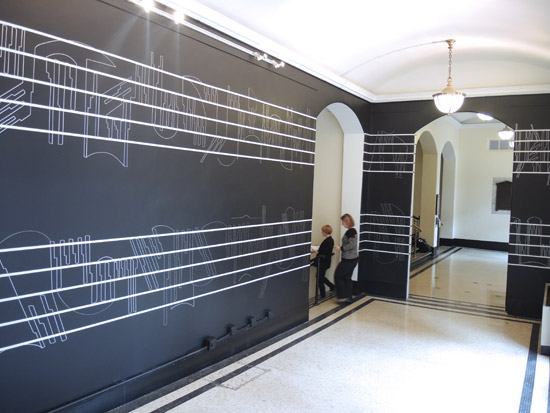
"Vector Composition No. 1" by Vargas-Suarez Universal, 2013. Acrylic, enamel and tape in-situ wall drawings. The Miller Theater at Columbia University, New York.
.
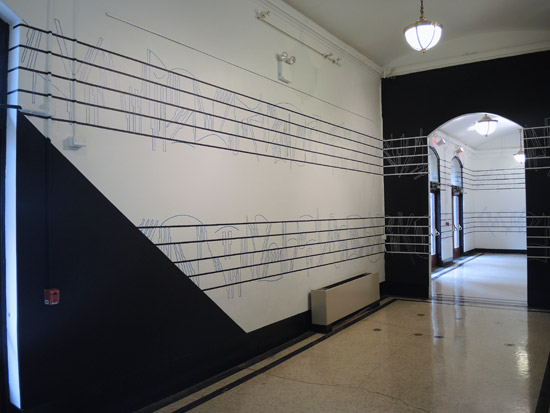
"Vector Composition No. 1" by Vargas-Suarez Universal, 2013. Acrylic, enamel and tape in-situ wall drawings. The Miller Theater at Columbia University, New York.
.
Curated by Deborah Cullen, director and chief curator of the Wallach Art Gallery at Columbia University, the commissioned piece by Vargas-Suarez Universal is a collaboration with the Miller Theatre, which is known for presenting a continuing program of music and often commissioning contemporary composers to create music for some of the performance series.
Prior to this opportunity, Vargas-Suarez Universal—for whom music is a significant reference—had already been drawing in a notebook of musical staff sheets. Presented with the Miller Theatre commission, he recognized that these drawings could be translated into a mural referencing musical notation.
.
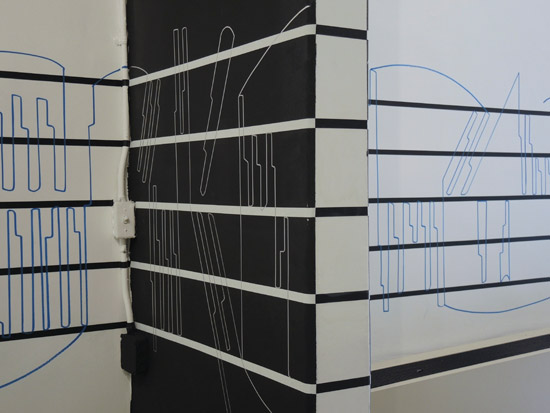
"Vector Composition No. 1" by Vargas-Suarez Universal, 2013. Acrylic, enamel and tape in-situ wall drawings. The Miller Theater at Columbia University, New York.
.
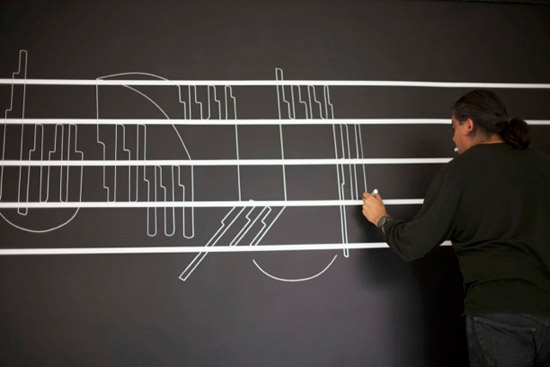
"Vector Composition No. 1" by Vargas-Suarez Universal, 2013. Acrylic, enamel and tape in-situ wall drawings. The Miller Theater at Columbia University, New York.
.
On-site materials were again re-utilized, all the black theater paints mixed to achieve what the staff called “super black.” The main theater entrance wall was painted along with an archway leading to another building entrance, the remainder left white, save for the base and a black angle that delineates an end (or beginning) at the other entrance doorway.
Black sets the arches in relief; architectural details stand out, including the black lines in the floor tiles. In a particularly interesting trick to the eye, black paint was taken slightly around the edges of the walls to create a softening effect.
Using white tape on the black walls and black tape on the white walls, Vargas-Suarez Universal laid out treble and bass staff lines and proceeded to translate a “musical composition” through his vector code drawn in enamel paint, light blue on the white walls, silvery white on the black.
What could have previously felt like an inanimate space—despite its activities and continuous traffic, not to mention the historical significance of its architecture, designed as it was by the recognized turn of the 20th century firm of McKim, Mead & White—is now quite alive with the artist’s abstract geometric vision of a musical score.
On view officially through May and likely through the summer, Vector Composition No. 1 in the Miller Theatre Lobby is an altering experience for the viewer. Combine a visit to Columbia with a stop at the university's Miriam and Ira D. Wallach Art Gallery, presenting an MFA Exhibition now through April, as well as the LeRoy Neiman Center for Print Studies and the LeRoy Neiman Gallery, exhibiting the group show "United Against Speculation" through April 10, organized by Rikrit Tiravanija and Tomas Vu.
.
Vargas-Suarez Universal opens his studio to students and tour groups by appointment. His first catalog will be published this spring by Gallery Geranmayeh, New York, including an interview with art historian Carla Stellweg.
The artist’s project "Search for Life: Aliens, Water and Surveillance" (2008) will be featured in the upcoming book "Curating at the Edge: Artists Respond to the US/Mexico Border" by Kate Bonansinga, with a foreword by Lucy Lippard. To purchase a copy or for more info, go to: www.press.utexas.edu.
BASIC INFO:Vector Composition No. 1 by Vargas-Suarez Universal is on view through May at Columbia University’s Miller Theatre, 2960 Broadway, New York, NY 10027. www.millertheatre.com.
The Miller Theatre is located on the Columbia University campus at Broadway and 116th Street, approximately 25 minutes from midtown by subway. The theater entrance is on the east side of Broadway, just north of the university’s main gates.
Art and information on Vargas-Suarez Universal can be found at www.vargassuarezuniversal.com.
